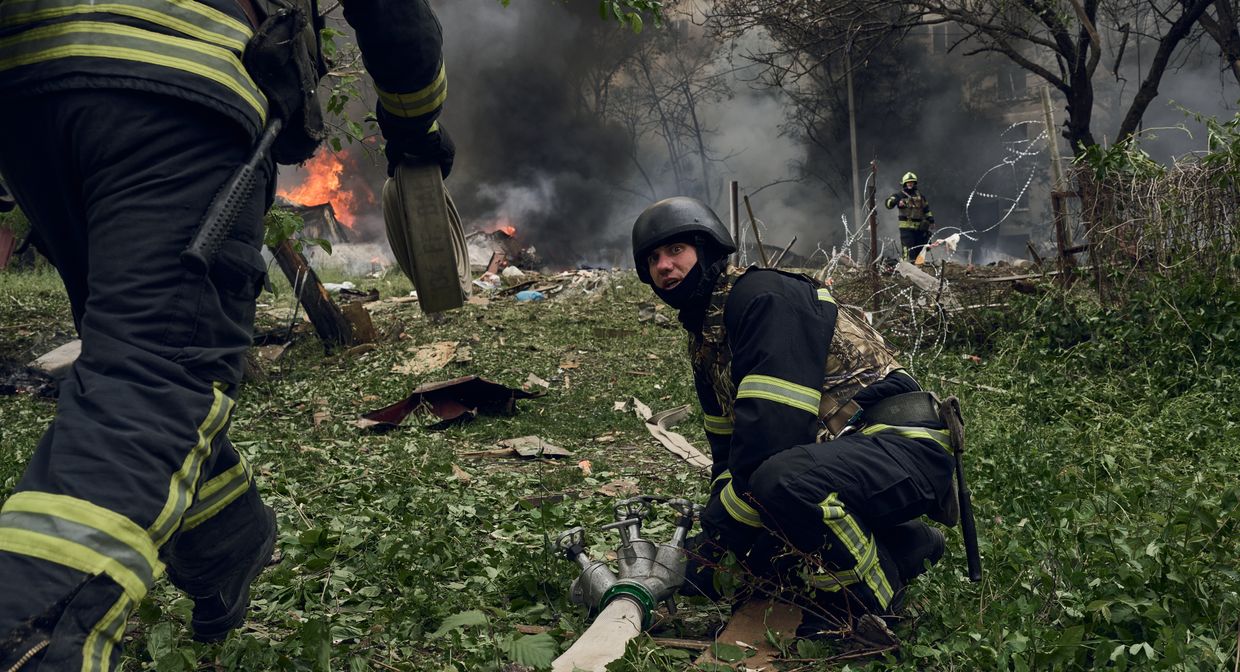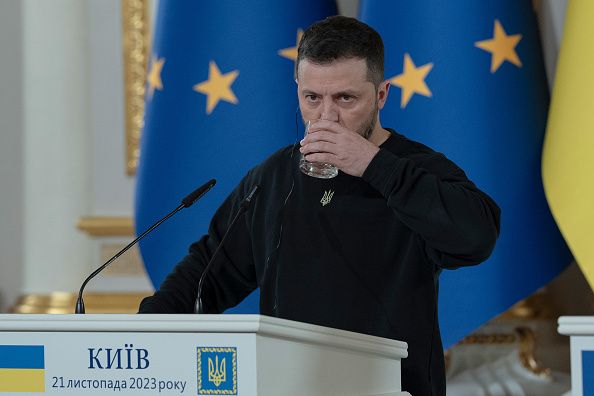Four people die and around 70 are injured in Russian attacks on Kharkiv over the weekend

Important developments on 22 and 23 June:
- Russian attacks damage energy infrastructure in several Ukrainian regions
- Russian attack on Kharkiv on June 22 leaves three dead and 56 injured, including children
- Russia claims Ukraine attacked Sevastopol with five ATACMS missiles
- General Staff: Ukrainian forces attack command posts in Russia’s Belgorod region
- Ukrainian army reports withdrawal of some Russian troops from Vovchansk region
- Fighting continues in Toretsk sector as reports come in of captured village in ‘gray zone’
On the night of June 22, Russian troops launched missile and drone attacks on several regions of Ukraine, targeting critical energy infrastructure.
The Ukrainian Energy Ministry said that attacks on energy transmission systems had occurred in the southern and western regions of Ukraine, damaging equipment.
Russia has recently stepped up its attacks on Ukraine’s critical infrastructure, with another attack on the country’s energy grid causing power outages. The overnight attack was the eighth such massive attack in recent months.
In Zaporizhia Oblast, two energy workers were injured in the attack and taken to hospital, grid operator Ukrenergo wrote on social media. In Lviv Oblast, a Russian missile hit an energy infrastructure facility and caused a fire, Governor Maksym Kozytskyi reported.
On June 22, at around 5 a.m., explosions were heard in the northwestern city of Lutsk in the Volyn and Vinnytsia oblasts, as well as in the city of Khmelnytskyi.
Ukrainian air defenses shot down all 13 Shahed attack drones and 12 of the 16 missiles fired by Russia overnight, the Air Force reported.
Russian attacks are pushing Ukraine’s energy system toward ‘worst-case scenario’, says largest private energy company
In a worst-case scenario, Ukrainians could face up to 20 hours of power outages a day if the country cannot repair its energy infrastructure and adequately protect it from Russian attacks, Dmytro Sakharuk, chief executive of DTEK, Ukraine’s largest private energy company, told the Kyiv Independent.

Glide bombs attacks on Kharkiv
On June 22, Russian forces attacked the city of Kharkiv with glide bombs, killing three people and injuring 56, according to Governor Oleh Syniehubov.
A Russian glide bomb damaged a five-story residential building, a private house, five non-residential buildings, 16 commercial pavilions, 25 vehicles, a trolleybus, two pharmacies and a car dealership.
Three more glide bombs hit an enterprise in Kholodnohirskyi district, injuring four people and killing one, Syniehubov reported.
Moscow has recently intensified its attacks on Kharkiv, Ukraine’s second-largest city, using missiles, glide bombs and drones that have destroyed energy infrastructure and killed civilians.
On June 23, Russia launched another glide bombing attack on Kharkiv, hitting civilian infrastructure.
At least one person was reported killed and 12 people injured.
Russian troops attacked Kharkiv with three gold bombs, damaging an educational institution and multi-storey residential buildings in the city’s Shevchenko district, Syniehubov reported. In Kholodnohirskyi district, the attack destroyed two private houses.
Parts of Kharkiv are currently without electricity and the subway is not functioning, said President Volodymyr Zelensky after the attack.
“We will definitely restore everything and return to normality. We are working as hard as possible to deprive the Russians of the opportunity to terrorize our cities,” he wrote on Telegram.
“Modern air defense systems for Ukraine, powerful combat aircraft, long-range weapons and sufficient determination on the part of our partners will certainly be able to stop the Russian terrorists.”
Glide bombs are helping Russia gain ground in Ukraine. What makes them so effective?
A key factor in Russia’s recent battlefield successes in Ukraine has been its extensive use of glide bombs. Hundreds of these large, deadly weapons rain down on Ukraine every week, leaving craters 20 meters wide and wiping out military positions and entire settlements. Russia relies heavily on its bombs.

Russia claims Ukraine attacked Sevastopol with 5 ATACMS missiles
The Russian Defense Ministry claimed on June 23 that Ukraine had launched an attack on Sevastopol, a city in Russian-occupied Crimea, using five American ATACMS long-range missiles.
Ukraine regularly attacks the military infrastructure in occupied Crimea.
Four missiles were shot down by Russian air defenses, while the warhead of the fifth “exploded over the city,” the Russian Defense Ministry claimed.
Mikhail Razvozhaev, the head of the illegal Russian occupation government in Sevastopol, claimed that four people were killed in the attack, including two children, and 144 injured.
Earlier on the same day, Russian Telegram channels published photos and videos of the alleged attack and reported that many people were injured on the beach in Uchkuevka, a village in northern Sevastopol.
The reports could not be independently verified and Ukraine had not commented on the matter at the time the news was published.
Latest news on the Ukraine war: Ukraine claims responsibility for attack on 4 refineries and Shahed drone depot in Russia
Key developments on June 21: * Ukraine attacks 4 refineries and Shahed drone depots in Russia, military says * Russia attacks Chasiv Yar from Toretsk direction, military says * Media: Officials say the amount of South Korea’s arms supplies to Ukraine will depend on Russia’s actions * Russian…

Ukrainian forces reportedly hit command post in Russia’s Belgorod region
The Ukrainian military attacked a command post of a Russian motorized rifle regiment in Nekhoteyevka, Belgorod region, the General Staff of the Ukrainian Armed Forces reported on the morning of June 23.
Nekhoteyevka is a village near the Russian-Ukrainian border, about 30 kilometers southwest of the city of Belgorod.
According to the General Staff, the attack was carried out by the Ukrainian Air Force in cooperation with other branches of the military.
“As a result of the fighting, explosions were recorded. The target was successfully hit,” the report said. The Kyiv Independent could not immediately confirm this information.
An hour after the General Staff report, Vyacheslav Gladkov, the governor of Russia’s Belgorod region, reported by telegram several attacks on his region, but made no mention of an attack on Nekhoteyevka.
Selenskyj on attacks within Russia: “It works, just as we expected”
President Volodymyr Zelensky praised the success of attacks on Russia’s interior using weapons from the West, saying the ability to “hit the positions and launch pads of Russian terrorists near the border … is really important.”

Military says some Russian troops withdrawing from Vovchansk area
Some of the Russian forces are withdrawing from the area near Vovchansk in Kharkiv Oblast to get reinforcements as their combat capability has declined, Khortytsia Group of Forces spokesman Nazar Voloshin said on national television on June 22.
Russia launched a new offensive in northern Kharkiv Oblast on May 10, and Vovchansk became the scene of some of the heaviest fighting. Moscow’s forces had advanced as far as 10 kilometers into the region, but were stopped by the first line of defense.
Russia is “stuck” in the contested city of Vovchansk, but is continuously supplementing its forces with units from other directions, said the commander-in-chief of the Ukrainian armed forces, Oleksandr Syrskyi, on June 12.
The retreat of Russian units was also observed near the villages of Lyptsi and Tyche, where Russian forces suffered losses, Voloshin said.
Voloshin said the Russian army had lost 60 percent of its soldiers in this direction of the front, including both dead and wounded.
“This indicates that the enemy has ceased active hostilities in this area, since there were no such operations last day and this morning,” Voloshin said.
Russia’s move in Kharkiv has stalled. Was it a failure?
In the first half of May, Russia dramatically opened a new front in its war against Ukraine. The two-pronged offensive on Kharkiv Oblast came after the most difficult months for the Ukrainian armed forces, which were overwhelmed and exhausted after a brutal winter and spring campaign.

Fighting ongoing in Toretsk sector amid reports of captured village in 'gray zone'
Ukrainian forces held back a Russian attack in the Horlivka-Toretsk direction in Donetsk region on June 22 amid ongoing fighting, Voloshin told the Kyiv Independent.
His statement comes as Moscow’s troops reportedly stepped up their attacks near the city of Toretsk following a “long lull in fighting” in the region.
Toretsk, the strategically important city less than eight kilometers from the front, had about 31,000 inhabitants before the start of the large-scale invasion.
According to crowdsourcing surveillance service DeepState, Russian troops have reportedly captured the village of Shumy, located about ten kilometers east of Toretsk.
“No map can show you what is really happening at the front. Everything is completely different there and no conclusions can be drawn about the breakthrough at the front or its stabilization,” Voloshin told the Kyiv Independent.
All eyes are on Kharkiv: Russian troops conquer one Donbass village after another
Editor’s note: The Kyiv Independent is not publishing the full names of the soldiers because they disclosed information without the authorization of their command. DONETSK OBLAST – While public attention is focused on Moscow’s renewed offensive in Kharkiv Oblast, Russian forces are steadily advancing in the country’s eastern regions…




